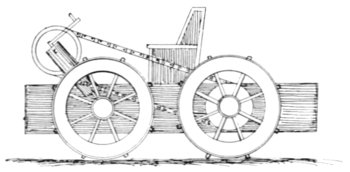vented by skillfully contrived mechanical devices so as to obtain something from nothing. The body of the carriage was used as a reservoir for the compressed air, and within the wheels were placed a number of pumps, the short bars projecting from the peripheries being the ends

Fig. 8. Compressed Air Wagon, Made about 1810.
of the plungers. The expectation was that as the wheels revolved, the plungers would be depressed, and thus air would be pumped into the reservoirs and this air would operate the engine that propelled the vehicle; hence the apparatus would supply its own power, and realize perpetual motion. If this attempt to controvert the laws of nature had not been relied upon, better results might have been obtained.
The highly ornamental coach shown in Fig. 9 was invented by Dr. Church about 1832. In addition to being ornamental, it was of massive construction and large capacity, being able to accommodate fifty passengers. Its operation is said to have been very satisfactory, a high rate of speed being attained and all grades on ordinary roads being easily mounted. The inventor swamped himself in endeavoring to compete with railroads.

Fig. 9. Side View of Dr. Church's Steam Coach, Made in 1832.
Perhaps the most perfect of all the early automobiles was the one devised by Scott Russell, the celebrated designer of the Great Eastern. This carriage is shown in Fig. 10. It was operated successfully, and was able to mount the steepest hills and to attain a high rate of speed,
